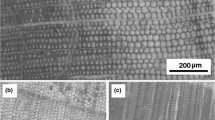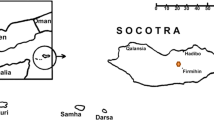Abstract
Measurements of variation in the diameter of tree stems provide a rapid response, high resolution tool for detecting changes in water tension inside the xylem. Water movement inside the xylem is caused by changes in the water tension and theoretically, the sap flow rate should be directly proportional to the water tension gradient and, therefore, also linearly linked to the xylem diameter variations. The coefficient of proportionality describes the water conductivity and elasticity of the conducting tissue. Xylem diameter variation measurements could thus provide an alternative approach for estimating sap flow rates, but currently we lack means for calibration. On the other hand, xylem diameter variation measurements could also be used as a tool for studying xylem structure and function. If we knew both the water tension in the xylem and the sap flow rate, xylem conductivity and/or elasticity could be calculated from the slope of their relationship. In this study we measured diurnal xylem diameter variation simultaneously with sap flow rates (Granier-type thermal method) in six deciduous species (Acer rubrum L., Alnus glutinosa Miller, Betula lenta L., Fagus Sylvatica L. Quercus rubra L., and Tilia vulgaris L.) for 7–91 day periods during summers 2003, 2005 and 2006 and analyzed the relationship between these two measurements. We found that in all species xylem diameter variations and sap flow rate were linearly related in daily scale (daily average R 2 = 0.61–0.87) but there was a significant variation in the daily slopes of the linear regressions. The largest variance in the slopes, however, was found between species, which is encouraging for finding a species specific calibration method for measuring sap flow rates using xylem diameter variations. At a daily timescale, xylem diameter variation and sap flow rate were related to each other via a hysteresis loop. The slopes during the morning and afternoon did not differ statistically significantly from each other, indicating no overall change in the conductivity. Because of the variance in the daily slopes, we tested three different data averaging methods to obtain calibration coefficients. The performance of the averaging methods depended on the source of variance in the data set and none of them performed best for all species. The best estimates of instantaneous sap flow rates were also given by different averaging methods than the best estimates of total daily water use. Using the linear relationship of sap flow rate and xylem diameter variations we calculated the conductance and specific conductivity of the soil–xylem–atmosphere water pathway. The conductance were of the order of magnitude 10−5 kg s−1 MPa−1 for all species, which compares well with measured water fluxes from broadleaved forests. Interestingly, because of the large sap wood area the conductance of Betula was approximately 10 times larger than in other species.







Similar content being viewed by others
References
Aasamaa K, Soeber A (2005) Seasonal courses of maximum hydraulic conductance in shoots of six temperate deciduous tree species. Fun Plant Biol 32:1077–1087
Bogeat-Triboult M-B, Martin R, Chatelet D, Cochart H (2002) Hydraulic conductance of root and shoot measured with the transient and dynamic modes of the high-pressure flowmeter. Ann For Sci 59:389–396
Braun P, Schmid J (1999) Sap flow measurements ti grapevines (Vitis vinifera L.). 2 Granier measurements. Plant Soil 215:47–55
Burgess SSO, Bleby TM (2006) Redistribution of soil water by lateral roots mediated by stem tissues. J Exp Bot 57:3283–2391
Clearwater MJ, Meinzer FC, Andrade JL, Goldstein G, Holbrook NM (1999) Potential errors in measurement of nonuniform sap flow using heat dissipation probes. Tree Physiol 19:681–687
Daubet F-A, Améglio T, Cochard H, Afrchilla O, Lacointe A (2005) Experimental analysis of the role of water and carbon in three stem diameter variations. J Exp Bot 56:135–144
Do F, Rocheteau A (2002) Influnece of natural temperature gradients on measurements of xylem sap flow with thermal dissipation probes 2. Advantages and calibration of a noncontinuous heating system. Tree Physiol 22:649–654
Domec J-C, Meinzer FC, Gartner BL, Woodruff D (2005) Transpiration-induced axial and radial tension gradients in trunks of Douglas-fir trees. Tree Physiol 26:275–284
Granier A (1985) Une novelle méthode pour la mesure du flux de sève brute dans le tronc des arbes. Ann For Sci 42:193–200
Green DW, Winandy JE, Kretschmann DE (1999) Mechanical properties of wood. In wood handbook. USDA Forest Products Laboratory, Madison Wisconsin, pp 4–1–4-46
Henzler T, Waterhouse RN, Smyth AJ, Carvajal M, Cooke DT, Schäffner AR, Steudle E, Clarkson DT (1999) Diurnal variations in hydraulic conductivity and root pressure can be correlated with the expression of putative aquaporins in the roots of Lotus japonicus. Planta 210:50–60
Irvine J, Grace J (1997) Continuous measurement of water tensions in the xylem of trees based on the elastic properties of wood. Planta 202:455–461
Köstner B, Granier A, Cermák J (1998) Sapflow measurements in forest stands: methods and uncertainties. Ann For Sci 55:13–27
Nardini A, Tyree MT (1999) Root and shoot hydraulic conductance of seven Quercus species. Ann For Sci 56:371–377
Neher HV (1993) Effects of pressure inside Monterey pine trees. Trees 8:9–17
Offenthaler I, Hietz P, Richter H (2001) Wood diameter indicates diurnal and long-term patterns of xylem water potential in Norway spruce. Trees 15:215–221
Orians CM, van Vuuren MMI, Harris NL, Babst BA, Ellmore GS (2004) Differential sectoriality in long-distance transport in temperate tree species: evidence from dye flow, N transport and vessel element pitting. Trees 18:501–509
Perämäki M, Nikinmaa E, Sevanto S, Ilvesniemi H, Siivola E, Hari P, Vesala T (2001a) Tree stem diameter variations and transpiration in Scots pine: an analysis using a dynamic sap flow model. Tree Physiol 21:889–897
Perämäki M, Vesala T, Nikinmaa E (2001b) Analysing the applicability of the heat balance method for estimating sap flow in boreal forest conditions. Boreal Environ Res 6:29–43
Perämäki M, Vesala T, Nikinmaa E (2005) Modeling the dynamics of pressure propagation and diameter variation in tree sapwood. Tree Physiol 25:1091–1099
Phillips NG, Oren R, Licata J, Linder S (2004) Time series diagnosis of tree hydraulic characteristics. Tree Physiol 24:879–890
Pilegaard K, Mikkelsen TN, Beier C, Jensen NO, Ambus P, Ro-Poulsen H (2003) Field measurements of atmosphere–biosphere interactions in a Danish beech forest. Boreal Environ Res 8:315–333
Sevanto S, Vesala T, Perämäki M, Nikinmaa E (2001) Xylem diameter changes as an indicator of stand-level evapo-transpiration. Boreal Environ Res 6:45–52
Sevanto S, Vesala T, Perämäki M, Nikinmaa E (2002) Time lags for xylem and stem diameter variations in a Scots pine tree. Plant Cell and Environ 25:1071–1077
Sevanto S, Vesala T, Perämäki M, Nikinmaa E (2003) Sugar transport together with environmental conditions controls time lags between xylem and stem diameter changes. Plant Cell and Environ 26:1257–1265
Sevanto S, Hölttä T, Markkanen T, Perämäki M, Nikinmaa E, Vesala T (2005a) Relationships between diurnal diameter variations and environmental factors in Scots pine. Boreal Environ Res 10:447–458
Sevanto S, Hölttä T, Hirsikko A, Vesala T, Nikinmaa E (2005b) Determination of thermal expansion of green wood and the accuracy of tree stem diameter variation measurements. Boreal Environ Res 10:437–445
Sperry JS, Hacke UG, Pittermann J (2006) Size and function in conifer tracheids and angiosperm vessels. Am J Bot 93:1490–1500
Tisser J, Lambs L, Peltier J-P, Marigo G (2004) Relationship between hydraulic traits and habitat preference for six Acer species occurring in the French Alps. Ann For Sci 61:81–86
Tyree MT, Yang S (1990) Water-storage capacity of Thuja, Tsuga and Acer stems measured by dehydration isotherms. Planta 182:420–426
Ueda M, Shibata E (2001) Diurnal changes in branch diameter as indicator of water status of Hinoko cypress Chamaecyparis obtuse. Trees 15:315–318
Wang JR (2005) Spring and summer hydraulic conductivity of 14 woody species of the sub-boreal forest in British Columbia. Can J For Res 35:2727–2733
Woodrum CL, Ewers FW, Telewski FW (2003) Hydraulic, biomechanical and anatomical interactions of xylem from five species of Acer (Aceraceae). Am J Bot 90:693–699
Zweifel R, Item H, Häsler R (2001) Link between diurnal stem radius changes and tree water relations. Tree Physiol 21:869–877
Zwieniecki MA, Holbrook NM (1998) Diurnal variation in xylem hydraulic conductivity in white ash (Fraxinus americana L.), red maple (Acer rubrum L.) and red spruce (Picea rubens Sarg.). Plant Cell and Environ 21:1173–1180
Acknowledgements
The support of Harvard Forest, The Andrew W. Mellon Foundation and Academy of Finland project #208492 is thankfully acknowledged.
Author information
Authors and Affiliations
Corresponding author
Additional information
Responsible Editor: Stephen S.O. Burgess.
Rights and permissions
About this article
Cite this article
Sevanto, S., Nikinmaa, E., Riikonen, A. et al. Linking xylem diameter variations with sap flow measurements. Plant Soil 305, 77–90 (2008). https://doi.org/10.1007/s11104-008-9566-8
Received:
Accepted:
Published:
Issue Date:
DOI: https://doi.org/10.1007/s11104-008-9566-8




